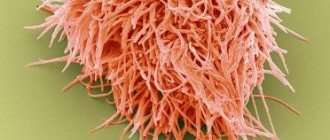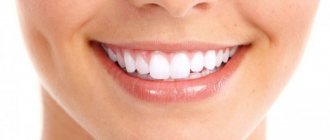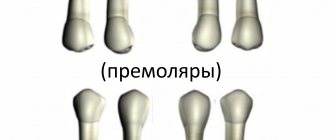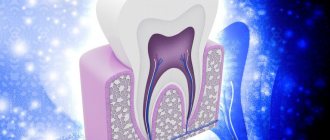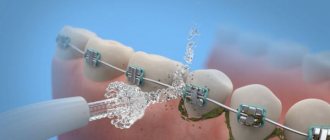Chemical composition of enamel - organic and inorganic components
Enamel is the outer protective layer that covers each tooth. Dentin is hidden under it, and under it is the pulp chamber with a neurovascular bundle, pulp. In this case, the enamel layer covers only the crown (the visible part of the tooth), which passes into the neck, and that into the root. The surface of the root system is covered with cement - a solid mixture of collagen and calcium fibers. We can say that this is the dentogingival connection, because with its help the root is securely attached to the alveolus.
The top layer of teeth is considered the hardest tissue in the human body, which is due to the presence of mineral components of tooth enamel in its composition. It contains mainly calcium phosphate in the form of hydroxyapatite crystals - approximately 95-97%. The remaining part is accounted for by organic substances, and this is only 1-2%. The rest is water, approximately 2-3%.
Chemical composition of tooth enamel
The most durable are the surface layers, especially on the cutting edges and chewing surfaces of the incisors, canines and molars. Closer to the cervical region, the degree of tissue hardness decreases. At the same time, the thickness of this layer is not evenly distributed throughout the entire crown. So, for example, on the chewing surface it can be 1.5-1.6 mm, but on the sides and at the very base the enamel will be much thinner.
Tooth enamel (or simply enamel) is the outer protective shell of the crown portion of human teeth.
Enamel is the hardest tissue in the human body, which is explained by the high content of inorganic substances - up to 97%. .The main function of enamel is to protect dentin and pulp from external mechanical, chemical and temperature irritants. Only thanks to this the tooth fulfills its purpose - biting and grinding food.
Structure and composition
The causes of tooth enamel destruction can be bacterial or chemical exposure, as well as mechanical damage. Color shades vary on the white scale from pale gray to light yellow. However, tooth enamel itself is almost transparent, so the basic color of the tooth depends primarily on the color of the dentin.
Chemical composition
The hardness of tooth enamel is determined by its high content of inorganic substances (up to 97%), mainly crystals of hydroxyapatite - Ca10(PO4)6(OH)2, modified by the presence of magnesium, fluorine, carbon and some other elements. Healthy enamel contains 2-3% free water and 1-2% organic substances (proteins, lipids, carbohydrates). Water occupies free space in the crystal lattice and organic base, and is also located between the crystals.
Hydroxyapatites are very susceptible to acids and begin to degrade noticeably at pH < 4.5 (saliva has a pH of 5.6 to 7.6).
The thickness of the enamel varies in different parts of the tooth surface. So, on the chewing surface this layer reaches two millimeters, gradually thinning closer to the root of the tooth. The chewing surface of the tooth most of all needs such a durable coating, since it bears a large functional load. However, the root areas of the tooth remain the most vulnerable area; most often, the proliferation of microorganisms that provoke caries begins from here. After the destruction of enamel, pathogenic microflora easily moves deep into the tooth, right up to the pulp, especially since dentin (the second layer of tissue after enamel) has a porous and relatively soft structure. Carious cavities are formed, which often reach such sizes that to restore a tooth, only a filling is not enough, but prosthetics are necessary.
What factors provoke enamel damage?
The following factors lead to enamel damage:
- Damage to the enamel, thinning and cracks on its surface may be a sign of a lack of fluorine and calcium minerals, as well as a lack of vitamins
- The opposite situation, in which too much fluoride enters the body, provokes fluorosis, which also worsens the condition of the enamel, causing stains to appear on its surface.
- Hereditary predisposition - enamel is more often damaged in those people whose layer is naturally thin;
- Improper hygiene - a toothbrush with increased rigidity for teeth with thinned enamel, lack of the habit of rinsing your mouth after meals and brushing your teeth twice a day.
- Diets rich in acids, such as citrus fruits and other acidic fruits. Acids, when used daily, gradually thin the enamel, leaching minerals from it, which is a prerequisite for its destruction.
- Excessive mechanical stress on the teeth - too hard food that needs to be chewed thoroughly, the habit of opening bottles and cracking nuts with teeth, cracking seeds; enamel can deteriorate in people who bite their nails;
- Smoking, chocolate and other sweets, alcohol, sweet soda and coffee in large quantities also negatively affect the condition of tooth enamel;
- Anatomical features of the structure of teeth, for example, deep and branched fissures;
- Systemic diseases affecting the general condition of the body;
- Chemical composition of saliva. Saliva is a natural antibacterial and cleansing agent, protects teeth from damage by pathogenic bacteria and maintains the stability of the mineral composition of teeth;
- Problems with the digestive system;
How to preserve tooth enamel?
- Preventative dental examinations every six months will help you avoid serious complications.
- Maintain good oral hygiene, even if you are on vacation or on a business trip. Correct selection of personal hygiene products and their correct use.
- Adjust your diet and habits to reduce the number of factors that cause enamel damage. Avoid eating sweets, sour fruits and fruit juices, alcohol and coffee;
- Give up the habit of biting your nails, cracking seeds and opening bottles with your teeth;
- Enrich your menu with products that are rich in microelements and vitamins. In the autumn-winter season, take multivitamin complexes.
Enamel restoration: (regeneration)
Unfortunately, the structure of tooth enamel is such that when it is destroyed, natural tissue regeneration is impossible, unlike the natural regeneration of, for example, broken bones or wounded skin. However, this does not mean that it is impossible to restore damaged enamel.
With minor destruction, fluoride-containing preparations can help. calcium-containing preparations such as varnishes and gels. They do not restore enamel, but strengthen it and make it more resistant to external influences. These drugs are most often applied with a thin brush in the dentist’s office or using applications in individual spoons, but there are also those that the patient can independently use at home. Of course, only after consultation and prescription by a doctor.
In case of serious damage to the enamel, calcium phosphate is used in an amorphous state. When applied to a tooth, it enters into a chemical reaction and is converted into apatite, which is similar in structural composition to enamel apatites. This method helps not only eliminate the visible defect, but also relieve the increased sensitivity of the diseased tooth, as well as give it an aesthetic appearance.
In addition to fluoridation, the teeth remineralization procedure, which also uses a special varnish, is highly effective. In addition to fluorine, remineralization varnish contains a lot of other useful components that restore the mineral composition of the enamel and prevent its destruction. Remineralization is carried out at the same frequency as fluoridation - every six months. Its advantages include minimizing the risk of fluoride oversaturation, which distinguishes remineralization from fluoridation.
Restoring enamel with remineralization varnish is not carried out at once; it is necessary to undergo a course of procedures that give a cumulative effect.
Free consultation More about the clinic’s doctors
You can find out other details by calling clinic 8,
Main functions
The main functional task of this part of the tooth is the reliable protection of its internal structures - dentin and pulp. It is a barrier that prevents irritating mechanical, thermal and chemical effects on more sensitive and susceptible tissues. It is thanks to its hardness that we are able to bite and chew food freely and painlessly.
Generally speaking, teeth also help us reproduce sounds and, accordingly, speak. They are also responsible for the attractiveness of our smile and appearance in general, which ensures our comfort both psychologically and socially.
Enamel helps you bite and chew food
Subtleties of selection and application
When choosing any paint and varnish product, you must carefully study the manufacturer’s recommendations written on the can and follow them. Thus, you should not use enamel intended for interior work when painting outside, as well as in the opposite case.
It is also necessary to pay attention to the paint container itself; there should be no damage to it, otherwise a broken seal of the can can lead to loss of properties of the product. In addition, the shelf life of the finishing material should not be expired, otherwise the enamel paint will lose its quality. Without fail, the container must have “GOST” on it, this will avoid counterfeiting.
Meanwhile, it is necessary to take into account the peculiarities of using paints and varnishes. As for enamels, despite the fact that there are a huge number of types combined into one group, each type has individual technical characteristics. Thus, nitrocellulose enamels are an ideal means for treating wooden bases, and alkyd paints are characterized by a wide range of uses, which includes not only outdoor work and indoor painting, but also decorative painting.
A smooth base without visible defects does not need putty before painting; you can limit yourself to cleaning and priming the surface. When working with enamel paint, it is permissible to use thinners and solvents of any type.
When working with enamel paint, it is permissible to use thinners and solvents of any type.
Anatomical and histological structure of the enamel layer
The structure of tooth enamel includes several components. Among them, two main structural units can be distinguished - enamel prisms and interprismatic substance. Let's look at them in a little more detail.
Composition of enamel prisms
The histological structure of tooth enamel provides for the presence of prisms, which consist of special enamel-forming cells called ameloblasts. And the main distinguishing feature of these prisms is the fact that they continuously intersect the surface of the enamel throughout its entire thickness and are in a position perpendicular to the junction of enamel and dentin.
Interprismatic fabric
The part of histology that studies the structure of teeth also highlights interprismatic tissue. The main difference between this component and a prism is the direction of its crystals. Enamel tufts and plates pass through the thickness of the coating and represent hypomineralized zones. The plates, called lapellae, are peculiar defects that consist mainly of organic compounds. These, in turn, can facilitate the penetration of bacteria into the protective layer of teeth and thereby help the development of carious processes1.
The photo shows a diagram of the structure of tooth enamel
It should also be noted that processes of odontoblasts are also present in the interprismatic space. They largely determine the sensitivity of the enamel. The bottom line is that the bodies of odontoblasts are located in the pulp, where the nerve endings are concentrated. In this case, the processes of these cells are located directly in the enamel.
Susceptibility of enamel to carious processes
Despite its hardness, the protective layer of our teeth still remains quite susceptible to some pathological processes, in particular, to the development of caries. This disease is a consequence of the active reproduction and spread of bacteria, the waste products of which have a destructive effect on hard tissues.
Susceptibility to such processes may be due to various factors. Among them, experts in the field of dentistry highlight the underdevelopment of the enamel coating, which is an anomaly in the formation of the dental system. Caries also often results from poor nutrition, excessive consumption of foods rich in simple carbohydrates and sugars, and lack of vitamins and beneficial microelements in the diet.
Possible prerequisites for the development of carious processes also include insufficient hygiene, the formation of abundant plaque and deposits, internal systemic pathologies leading to changes in the composition of saliva and ph balance in the oral cavity.
PERIODONTAL
A major role in the aging of periodontal tissues is played by changes in blood vessels, collagen, enzyme activity, and immunobiological reactivity, when the processes of cell decay begin to prevail over the processes of their restoration. Metabolism slows down, oxygen supply to tissues decreases, and their dehydration increases. The composition of cellular elements changes and the level of lysozyme in the gum tissue decreases.
Therefore, the treatment of periodontal diseases always includes vitamin therapy, vascular and immunostimulating drugs, and all types of massage. It is absolutely necessary to strengthen the walls of blood vessels and strengthen the immune system constantly!
What pathological processes are the upper dental layer susceptible to?
To keep your teeth healthy and your smile snow-white and radiant, it is important to maintain hygiene and respond in a timely manner to any pathological changes occurring in the oral cavity. Unfortunately, most patients seek dental care in the later stages of the disease. Let's look at what possible problems can affect the condition of the enamel and lead to undesirable consequences.
Destruction by carious and non-carious processes
The cause of destruction of hard tissues can be both carious and non-carious processes. And if with the former everything is more or less clear, then the destruction of a non-carious nature requires a thorough examination of the body for serious systemic disorders.
Caries destroys tooth enamel
Side failures can occur both in the already formed body of an adult, and in a child at the stage of eruption of milk or permanent teeth, and even in a fetus at the stage of intrauterine development. In the latter case, the problem can be triggered by illness of the expectant mother or taking serious medications while carrying the baby. However, the weakening of enamel may also be associated with hormonal changes; for example, during pregnancy, many women complain of hyperesthesia.
Pathological abrasion
The prerequisites for this problem are often pathologies of the dental system, including various forms of malocclusion or crooked position of the teeth. However, the causes can also be neurological in nature, and this is often observed in childhood.
For example, some children grind their teeth loudly during sleep, which occurs due to an unconscious but very strong clenching of the jaws. In such cases, the child is usually referred to a neurologist, prescribed a course of sedatives and an individual mouthguard to be worn at night - it will protect the teeth from abrasion.
This is what tooth enamel wear looks like
“My child was diagnosed with increased abrasion and bruxism. This is when children grind their teeth loudly at night. There is a rumor that worms are to blame for everything, but this is complete nonsense. I worm him every year as expected. The doctor said that it could be nervous and prescribed special mouth guards. Now he sleeps with them, although at first he was capricious, didn’t want to put them on, saying they were in the way. Well, what can you do, you can’t walk around without teeth!”
Lyudmila, from correspondence on the woman.ru forum
Wedge-shaped defect
This pathology manifests itself as a V-shaped connection between the tooth and the gum. The defect occurs as a result of damage to the mucosa or drooping of its edge, and there are also many reasons for this phenomenon. This could be an incorrectly selected brush, an abnormal bite, a lack of micronutrients in the body, or excessive deposits in the subgingival area as a result of insufficient oral hygiene.
This is what a wedge-shaped defect looks like
Hypo- and hyperplasia
Hypoplasia is expressed in the partial absence of enamel in different parts of the tooth or its gradual thinning against the background of serious systemic disorders in the body. Hyperplasia is the opposite phenomenon, which is characterized by excessive formation of enamel tissue and heterogeneity in the structure of the outer shell of the teeth.
The photo shows tooth enamel hyperplasia
Erosive lesion
The pathology is very common, but its causes are still poorly understood. It is rarely possible to detect it in the early stages, and most often patients seek dental care when the enamel is already completely covered with erosive spots and does not cope well with its direct protective functions.
The photo shows erosion of tooth enamel
The presumable reasons for the development of such a pathological process are endocrine disorders and the use of potent medications, leading to demineralization and destruction of the tooth surface.
Is it possible to regenerate enamel?
The tissue that forms enamel does not have the ability to self-heal and regenerate. Therefore, it is so important to closely monitor its condition and respond to any changes in a timely manner. However, today we have quite a wide range of opportunities to strengthen the upper protective layer on the teeth in case of thinning. We are talking about modern methods of remineralization and fluoridation.
The photo shows the procedure for fluoridation of teeth
This may be a one-time procedure or a therapeutic course prescribed by a doctor. In this case, the teeth are coated with special varnishes with a high concentration of fluoride and calcium. They help increase the resistance of hard tissues to external aggressive factors, and also reduce their sensitivity - eliminate hyperesthesia. By the way, such varnishes are also applied every time after professional cleaning of plaque and deposits in the dentist’s office. Remember that this procedure must be completed every six months for prevention.
But in case of noticeable damage to the enamel layer, it is necessary to correct the defect by filling with preliminary removal of the affected tissue. In another case, the installation of veneers or even dentures may be recommended if the destruction has severely damaged the outer coronal part.
Personal hygiene basics
Of course, it is impossible to insure against dental diseases, but we can reduce the risk of their occurrence to the very minimum. To do this, it is enough to ensure proper oral hygiene, that is, regularly brush your teeth day and evening, use preventive rinses and flosses after each meal, try to eat healthy foods, including those rich in calcium and phosphorus, and also avoid smoking and excessive consumption sweets, flour, carbonated drinks and alcohol.
Proper oral hygiene will help keep your teeth healthy
It is also important not to forget to visit the dentist every six months for preventive examinations and removal of deposits. It is equally important to promptly treat any pathological changes in the cavity and not delay a visit to a specialist when the first suspicious symptoms appear.
Important elements for strengthening dental tissues
It is with the right foods that our body receives useful substances, vitamins and microelements, which are most directly involved in maintaining the health of teeth and gums. Dental experts strongly recommend incorporating foods rich in the following into your daily diet:
- calcium, fluorine and vitamin D - these substances form the basis for the formation of bone tissue, including enamel,
- B vitamins – support gum health and strengthen the dentogingival ligamentous apparatus,
- Vitamin C is an important component for the health of the body as a whole. Its sufficient intake into the body along with food reduces the risk of bleeding gums and loosening of teeth, protects against the formation of ulcers and tissue infection,
- vitamin E – promotes the regeneration of damaged tissues, reduces the sensitivity of the mucous membrane and its susceptibility to mechanical irritants,
- vitamin A - a deficiency of this component disrupts salivation processes and the structure of the enamel layer, causing it to become rough and heterogeneous.
Vitamins are involved in maintaining healthy teeth and gums.
All these substances are extremely important for the health of not only the oral cavity, but also the entire body. Proper nutrition, a healthy lifestyle, as well as careful caring attitude towards your body - all this has the most positive effect on the appearance and condition of our teeth.
1Ippolitov, Yu. A. Functional morphology of human enamel, 2010.
BONE
Every 30 years, bone tissue changes almost completely. Normally, by the age of 20, bone tissue reaches its peak mass. During this period, its growth is up to 8% per year. Bone tissue growth lasts up to 30-35 years, and annual growth depends on the degree of physical activity of a person. Then a natural decrease in bone mass begins by 0.3-0.5% per year. In women over 50 years of age, the maximum rate of bone loss is observed, which reaches 2-5% per year and continues at this rate until 60-70 years. As a result, women lose from 30 to 50% of bone tissue.
In men, these losses begin later and range from 15 to 30%.
Loss of bone tissue of the alveolar processes of the jaws is a big problem in modern dentistry. The older a person is, the more teeth, bone tissue, and overall health he has lost; but the more urgently it needs the treatment of periodontal diseases, targeted tissue regeneration, implantation and prosthetics.
